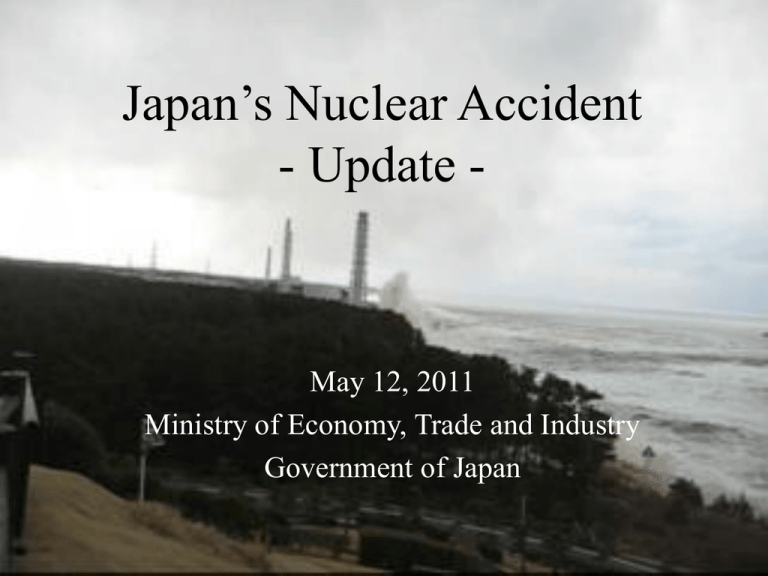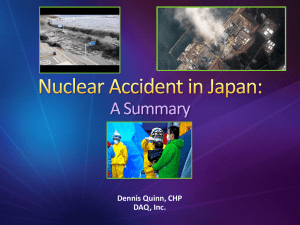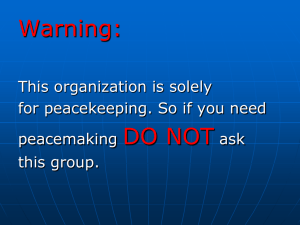Spent Fuel in the Pool
advertisement

Japan’s Nuclear Accident - Update - May 12, 2011 Ministry of Economy, Trade and Industry Government of Japan Table of Contents A. Japan Faces an Unprecedented Challenge (Enormous Earthquake, Tsunamis and Nuclear Accident) 1. Damage 2. Nuclear Power Stations B. Key Challenges 1. Cool Down the Reactors 2. Contain the Spread of Radioactive Substances (sea, soil and atmosphere) 3. Rigorous and Intensive Monitoring C. Impact on Energy Supply/Demand 1. Impact on Energy Supply/Demand in Japan D. Responsiveness to the World 1. Cooperation with International Organizations 2. Speedy Dissemination of Accurate Information 1 Great Support of the International Community Japan deeply appreciates the assistance offered from 142 countries and regions and 39 international organizations Rescue teams from 24 countries regions and international organizations US Navy/US Pacific Command (Operation Tomodachi) 2 A. Japan Faces an Unprecedented Challenge (Enormous Earthquake, Tsunamis and Nuclear Accident) Tsunamis 14 meters or higher Earthquakes: M - 9.0 quake (March 11) M - 7 class 5 times M - 6 class 63 times M - 5 class 335 times TOKYO■ Fukushima Dai-ichi 3 1. Damage Casualties : over 26,000 ・Dead : over 14,000 ・Missing : over 11,000 Evacuees : over 130,000 (As of April 25th) KYODO NEWS KYODO NEWS NOAA/US Dept of Commerce, http://wcatwc.arh.noaa.gov/ 4 2. Nuclear Power Stations Nuclear Reactors near Epicenter of the Earthquake 4 Nuclear Power Stations with 14 Units automatic shut down Onagawa Unit 1 524 MW, 1984Unit 2 825 MW, 1995Unit 3 825 MW, 2002Fukushima Dai-ichi Unit 1 460 MW, 1971Unit 2 784 MW, 1974Unit 3 784 MW, 1976Unit 4 784 MW, 1978Unit 5 784 MW, 1978Unit 6 1,100 MW, 1979Fukushima Dai-ni Unit 1 1,100 MW, 1982Unit 2 1,100 MW, 1984Unit 3 1,100 MW, 1985Unit 4 1,100 MW, 1987Tokai Dai-ni Unit 1 1,100 MW, 1978- cold shut down Periodical inspection 5 2. Nuclear Power Stations Fukushima Dai-ichi Nuclear Power Station Before the Earthquake and Tsunamis After the Earthquake and Tsunamis TEPCO Air Photo Service Inc (Myoko, Niigata Japan) 6 2. Nuclear Power Stations Fukushima Dai-ichi Nuclear Power Station Cause of the Damage Huge Tsunami 46 Meter Grid Line 46 Meter ① Loss of off-site power due to the earthquake Reactor Building About 40M About 20M Turbine Building Diesel Generator ② Diesel generator inoperable due to the tsunami Elevation: about 10m GE Hitachi Nuclear Energy Tsunami (estimated 14m) Breakwater 5.4 ~5.7m Seawater level All motion operated pumps including ECCS became inoperable Seawater Pump 7 B. Key Challenges 1. Cool Down the Reactors 2. Contain the Spread of Radioactive Substances (sea, soil and atmosphere) 3. Rigorous and Intensive Monitoring 8 1. Cool Down the Reactors (As of April 25th) 9 1. Cool Down the Reactors (Unit 1) (As of Apr 25th, 2011) Spray Damaged Spent Fuel Pool Cooling System Injecting fresh water or seawater The fuel pellets are presumed to be melting Major Events TEPCO Damaged Recovered Emergency Diesel Generator Residual Heat Removal System Fuel Bundle ・400 Spent Fuel in the Pool ・292 + 100 (new) External Power (Mar.24- connected to the central control room) ・Mar.12 - Venting started ・Mar.12 - Hydrogen explosion ・Mar.12 - Seawater injection to reactor core ・Mar.25 - Fresh water injection to reactor core ・Mar.31 - Fresh water spray by concrete pump trucks to spent fuel pool ・Apr. 7 - Injection of nitrogen to the primary containment vessel 10 1. Cool Down the Reactors (Unit 2) Damaged Spent Fuel Pool Cooling System Major Events Possible damage of the suppression chamber Ministry of Defense Recovered Emergency Diesel Generator Residual Heat Removal System Fuel Bundle ・548 Spent Fuel in the Pool ・587 + 28 (new) Injecting fresh water or seawater The fuel pellets are presumed to be melting Damaged (As of Apr 25th, 2011) External Power (Mar.26- connected to the central control room) ・Mar.13 - Venting started ・Mar.14 - Seawater injection to reactor core ・Mar.15 - Sound of explosion ・Mar.20 - Seawater injection to spent fuel pool (SFP) ・Mar.26 - Fresh water injection to reactor core ・Mar.29 - Fresh water injection to SFP 11 1. Cool 1. CoolDown Downthe theReactors Reactors (Unit (Unit 3) 3) (As of 18:30 April 8th, 2011) (As of Apr 25th, 2011) Spray Damaged Spent Fuel Pool Cooling System Injecting fresh water or seawater The fuel pellets are presumed to be melting Major Events Air Photo Service Inc (Myoko, Niigata Japan) Damaged Recovered Emergency Diesel Generator Residual Heat Removal System Fuel Bundle ・548 Spent Fuel in the Pool ・514 + 52 (new) External Power (Mar.22- connected to the central control room) ・Mar.13 - Venting started ・Mar.13 - Seawater injection to reactor core ・Mar.14 - Hydrogen explosion ・Mar.20 - Sprayed to spent fuel pool (SFP) by Tokyo Fire Department ・Mar.25 - Fresh water injection to reactor core ・Mar.27 - Fresh water spray by concrete pump trucks to SFP 12 1. Cool Down the Reactors 2. (Unit (Unit 4) 4) (As of(As 18:30 April25t 8th, 2011) h, 2011) of Apr Spray Damaged Spent Fuel Pool Cooling System Fuel Bundle ・0 Spent Fuel in the Pool ・1331 + 204 (new) No Fuel in Reactor Pressure Vessel Major Events Recovered Air Photo Service Inc (Myoko, Niigata Japan) External Power (Mar.29- connected to the central control room) ・Mar.15 - Fire occurred ・Mar.16 - Fire occurred ・Mar.20 - Seawater spray by Self- Defense Forces to spent fuel pool (SFP) ・Mar.25 - Seawater injection to SFP ・Apr. 7 - Fresh water spray by concrete pump trucks to SFP 13 1. Cool Down the Reactors (Unit 5&6) (As of Apr 25th, 2011) Fuel Bundle ・Unit5 : 548 Fuel Bundle ・Unit6 : 764 Spent Fuel in the Pool ・Unit 5 : 946 + 48 (new) Spent Fuel in the Pool ・Unit 6: 876 + 64 (new) Functioning Spent Spent Fuel Fuel Pool Pool Cooling Cooling System System KYODO NEWS Functioning External Power [Unit 5] Emergency Diesel Generator ResidualHeat HeatRemoval RemovalSystem System Residual Recovered External Power [Unit 6] (Mar.22- connected to the central control room) 14 2. Contain the Spread of Radioactive Substances (sea, soil and atmosphere) The Japanese Government and TEPCO are making the utmost efforts to prevent the dispersion of flow-out radioactive contaminated water. Artificial basin Major Events Locking in radioactive materials by spraying synthetic resin Unit 1 Unit 2 Suppression pool water surge tank Unit 3 Unit 4 Megafloat Contaminated water leak stopped Condensate storage tank ・Mar. 27 Stagnant water on the basement floor of the turbine of Unit2 and in the trenches found to be highly contaminated ・Mar. 29 Water in the storage tank started to be transferred to the surge tank, which is the preparation for transfer of stagnant water in the trenches. ・Apr. 1 Highly contaminated water discovered leaking into the sea ・Apr. 6 Leak of contaminated water into the sea was stopped ・Apr. 19 Transfer of stagnant water in the trench of Unit 2 started 15 2. Contain the Spread of Radioactive Substances (sea, soil and atmosphere) Experts are making the utmost efforts to prevent dispersing radioactive substances contained in dust, debris and vapor. Spraying synthetic materials on the surface of the ground and debris to prevent radioactive substances dispersion TEPCO 16 Roadmap towards Restoration from the Accident (announced by TEPCO on Apr.17) Mar.11 Apr.17 Around 3 months Around 6~9 months Step 1 Target Radiation dose in steady decline Step 2 Controlling release of radioactive materials (significant reduction of dose level) Stable cooling [Reactors] - Resume heat exchange function - [Unit 1,3] flood up to top of active fuel - [Unit 2] Seal the damaged location Stable cooling [Spent Fuel Pools] [Contaminated Water] [Contaminated Atmosphere/Soil] - Enhance reliability of water injection - Restore coolant circulation system - [Unit 4] Install supporting structure Secure storage place - Prevention of outflow to the outside of the site Prevention of spread Achieve cold shutdown More stable cooling - Keep sufficient level of water by remote-control - Resume heat exchange function Decrease contaminated water (decontamination and desalt) Install reactor building cover 17 3. Rigorous and Intensive Monitoring TEPCO monitors radioactivity levels every 10 minutes and releases the results immediately. Radioactivity levels rose on March 15th, but have since fallen and remain low. Environmental Radioactivity Level at the Fukushima Dai-ichi NPS Monitoring posts and the readings at the Fukushima Dai-ichi NPS (μSv/h) Unit 1~6 Near West Gate 21.0 μSv/h (μSv/h) Explosion in Unit2 12,000 Measurement point: Main Gate (1.0km from Unit2) or West Gate (1.1km from Unit2) White smoke from Unit3 4,000 2,000 Grayish smoke from Unit3 0 Main Gate 53.0 μSv/h (as of 10:00 April 25th, 2011) TEPCO 18 0.40 0.3 0.30 14-Mar 15-Mar 16-Mar 17-Mar 18-Mar 19-Mar 20-Mar 21-Mar 22-Mar 23-Mar 24-Mar 25-Mar 26-Mar 27-Mar 28-Mar 29-Mar 30-Mar 31-Mar 1-Apr 2-Apr 3-Apr 4-Apr 0.40 μSv/hour 0.3 0.30 Tokyo 230km 0.00 Osaka 400km 0.1 0.10 14-Mar 15-Mar 16-Mar 17-Mar 18-Mar 19-Mar 20-Mar 21-Mar 22-Mar 23-Mar 24-Mar 25-Mar 26-Mar 27-Mar 28-Mar 29-Mar 30-Mar 31-Mar 1-Apr 2-Apr 3-Apr 4-Apr 14-Mar 15-Mar 16-Mar 17-Mar 18-Mar 19-Mar 20-Mar 21-Mar 22-Mar 23-Mar 24-Mar 25-Mar 26-Mar 27-Mar 28-Mar 29-Mar 30-Mar 31-Mar 1-Apr 2-Apr 3-Apr 4-Apr 5-Apr 6-Apr 7-Apr Atmospheric Readings in Tokyo, Osaka and Sapporo (μSv/h) 0.40 (μSv/h) μSv/hour Max. 0.20 0.10 0.0 (μSv/h) μSv/hour 0.3 0.30 0.2 0.2 0.20 0.1 0.1 0.10 Min. MEXT Sapporo 630km Min. Max. Min. 0.0 0.00 Green box indicates normal range of radioactivity Max. 0.2 0.20 Fukushima Dai-ichi 0.0 0.00 19 INES Rating on the Events in Fukushima Dai-ichi NPS The Rating of the International Nuclear and Radiological Event Scale (INES) on Fukushima Dai-ichi Nuclear Power Station (NPS), in temporary assessed as Level 7. Chernobyl [5.2 million TBq] 7 Major Accident 6 Serious Accident 5 Accident with Wide Consequences 4 Accident with Local Consequences 3 Serious Incident 2 Incident 1 Anomaly 0 No Safety Significance Fukushima Dai-ichi [0.37~0.63 million TBq] Three Miles Island *Level 7 : more than several tens of thousands TBq131I *Level 6 : thousands to tens of thousands TBq131I *Level 5 : hundreds to thousands TBq131I 20 C. Impact on Energy Supply/Demand 1. Impact on Energy Supply/Demand 21 1. Impact on Energy Supply/Demand in Japan Tokyo Electric Power Company supplies electricity to an area with 42 million people and 40% of Japan’s GDP, but lost 40% of its generation capacity after the earthquake and tsunami. We are making the utmost efforts to match supply and demand during the peak-load summer on both the demand and supply side. 60 (GW) 52GW (Mar.11) Peak Demand of the Month Earthquake (Mar.11) 50 GW (Jul. 31) 50 Peak Demand of the Month 40 30 33GW (Mar.17) 31GW (Mar.14) 29GW (Mar.14) 20 10 Supply Capacity of TEPCO 0 Feb. Mar. Apr. May Jun. Jul. Aug. Sep. 22 D. Responsiveness to the World 1. Cooperation with International Organizations 2. Speedy Dissemination of Accurate Information 23 1. Cooperation with International Organizations International Atomic Energy Agency (IAEA) The March 19 Joint Statement Confirmed - No Restrictions on Travel to Japan International flight and maritime operations can continue normally into and out of Japan’s major airports and sea ports, excluding those damaged by the tsunami. International Maritime Organization (IMO) Screening for radiation of international passengers from Japan is not considered necessary at this time. World Meteorological Organization (WMO) Currently available information indicates that increased levels have been detected at some airports, but these do not represent any health risk. International Civil Aviation Organization (ICAO) World Health Organization (WHO) Joint Statement from above Five Organizations http://www2.icao.int/en/NewsRoom/Lists/News/Attachments/37/PIO.05.11.EN.pdf 24 2. Speedy Dissemination of Accurate Information • Japan is committed to the speedy dissemination of accurate information. • All necessary information are available below. Japan’s Countermeasures • 1.http://www.kantei.go.jp/foreign/incident/index.html • 2.http://www.meti.go.jp/english/index.html • 3.http://www.nisa.meti.go.jp/english/ Measurement of Radioactivity Level • • • • 1.http://www.mext.go.jp/english/topics/1305115.htm 2.http://www.nisa.meti.go.jp/english/ 3.http://www.worldvillage.org/fia/kinkyu_english.php 4. http://www.tepco.co.jp/en/press/corp-com/release/index-e.html Drinking Water Safety • 1.http://www.mhlw.go.jp/english/topics/2011eq/index.html • 2.http://www.waterworks.metro.tokyo.jp/press/shinsai22/press110324-02-1e.pdf Food Safety • 1.http://www.maff.go.jp/e/index.html • 2.http://www.mhlw.go.jp/english/topics/2011eq/index.html Ports and Airports Safety • 1.http://www.mlit.go.jp/page/kanbo01_hy_001428.html • 2.http://www.mlit.go.jp/koku/flyjapan_en/index.html • 3.http://www.mlit.go.jp/page/kanbo01_hy_001411.html 25 The people of Japan deeply appreciate the sympathy and assistance pouring in from people all over the world.







